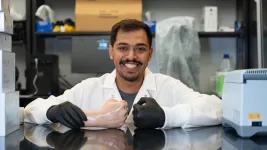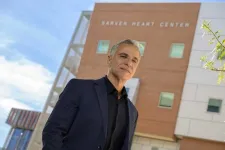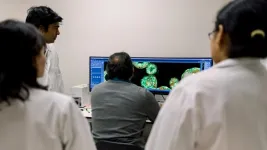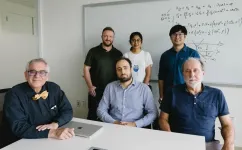(Press-News.org) As NASA’s Europa Clipper embarks on its historic journey to Jupiter’s icy moon, Europa, Dr. Matt Powell-Palm, a faculty member at Texas A&M University’s J. Mike Walker ‘66 Department of Mechanical Engineering, has unveiled groundbreaking research that could transform our understanding of icy ocean worlds across the solar system. The study published in Nature Communications, co-authored with planetary scientist Dr. Baptiste Journaux of the University of Washington, introduces a novel thermodynamic concept called the “centotectic” and investigates the stability of liquids in extreme conditions - critical information for determining the habitability of icy moons like Europa.
Revolutionizing the Search for Habitability
The exploration of icy ocean worlds represents a new frontier in planetary science, focusing on understanding the potential for these environments to support life. Powell-Palm’s research addresses a fundamental question in this field: under what conditions can liquid water remain stable on these distant, frozen bodies? By defining and measuring the cenotectic, the absolute lowest temperature at which a liquid remains stable under varying pressures and concentrations, the team provides a critical framework for interpreting data from planetary exploration efforts.
This study combines Powell-Palm’s expertise in cryobiology - specifically the low-temperature thermodynamics of water - initially focused on medical applications like organ preservation for transplantation, with Journaux’s expertise in planetary science and high-pressure water-ice systems. Together, they developed a framework that bridges disciplines to tackle one of the most fascinating challenges in planetary science.
“With the launch of NASA Europa Clipper, the largest planetary exploration mission ever launched, we are entering a multi-decade era of exploration of cold and icy ocean worlds. Measurements from this and other missions will tell us how deep the ocean is and its composition,” said Journaux. “Laboratory measurements of liquid stability, and notably the lowest temperature possible (the newly-defined cenotectic), combined with mission results, will allow us to fully constrain how habitable the cold and deep oceans of our solar system are, and also what their final fate will be when the moons or planets have cooled down entirely.”
A Texas A&M Legacy of Innovation in Space Research
The research was conducted at Texas A&M and led by mechanical engineering graduate student Arian Zarriz. The work reflects Texas A&M’s deep expertise in water-ice systems and tradition of excellence in space research, which spans multiple disciplines. With the recent groundbreaking of the Texas A&M Space Institute, the university is poised to play an even larger role in space exploration, providing intellectual leadership for missions pushing the boundaries of human knowledge.
“The study of icy worlds is a particular priority for both NASA and the European Space Agency, as evidenced by the flurry of recent and upcoming spacecraft launches,” said Powell-Palm. “We hope that Texas A&M will help to provide intellectual leadership in this space.”
Looking Ahead
As planetary exploration missions, such as those targeting icy moons, continue to expand our understanding of the solar system, researchers at Texas A&M and beyond prepare to analyze the wealth of data they will provide. By combining experimental studies like those conducted by Powell-Palm and Journaux with the findings from these missions, scientists aim to unlock the secrets of cold, ocean-bearing worlds and evaluate their potential to harbor life.
By Maddi Busby, Texas A&M Engineering
###
END
Texas A&M researchers illuminate the mysteries of icy ocean worlds
New research advances understanding of the habitability of icy moons
2024-12-21
ELSE PRESS RELEASES FROM THIS DATE:
Prosthetic material could help reduce infections from intravenous catheters
2024-12-21
In the holiday movie The Grinch, makeup artists are reported to have spent several hours each day encasing Jim Carrey’s face with prosthetics to create the iconic grumpy, green-furred creature. Such elaborate prosthetics, often made possible by materials like silicone rubbers, may have now found an unexpected yet beneficial biomedical engineering application, according to a new study from Texas A&M University.
Published in the journal Scientific Reports, researchers have created realistic, skin-like replicas made of Ecoflex, a type of silicone rubber that can potentially serve as a platform to evaluate risks of bacterial infections from ...
Can the heart heal itself? New study says it can
2024-12-20
A research team co-led by a physician-scientist at the University of Arizona College of Medicine – Tucson’s Sarver Heart Center found that a subset of artificial heart patients can regenerate heart muscle, which may open the door to new ways to treat and perhaps someday cure heart failure. The results were published in the journal Circulation.
According to the Centers for Disease Control and Prevention, heart failure affects nearly 7 million U.S. adults and is responsible for 14% of deaths per ...
Microscopic discovery in cancer cells could have a big impact
2024-12-20
In 2022 alone, over 20 million people were diagnosed with cancer, and nearly 10 million died from the disease, according to the World Health Organization. While the reaches of cancer are massive, the answer to more effective treatments may be hidden within a microscopic cell.
Led by Texas A&M University graduate students Samere Zade of the biomedical engineering department and Ting-Ching Wang of the chemical engineering department, an article released by the Lele Lab has uncovered new details about the mechanism behind cancer progression.
Published in Nature Communications, the article ...
Rice researchers take ‘significant leap forward’ with quantum simulation of molecular electron transfer
2024-12-20
Researchers at Rice University have made a meaningful advance in the simulation of molecular electron transfer — a fundamental process underpinning countless physical, chemical and biological processes. The study, published in Science Advances, details the use of a trapped-ion quantum simulator to model electron transfer dynamics with unprecedented tunability, unlocking new opportunities for scientific exploration in fields ranging from molecular electronics to photosynthesis.
Electron transfer, critical to processes such as cellular respiration and energy harvesting ...
Breakthrough new material brings affordable, sustainable future within grasp
2024-12-20
HOUSTON, Dec. 20, 2024 –While lithium-ion batteries have been the go-to technology for everything from smartphones and laptops to electric cars, there are growing concerns about the future because lithium is relatively scarce, expensive and difficult to source, and may soon be at risk due to geopolitical considerations. Scientists around the world are working to create viable alternatives.
An international team of interdisciplinary researchers, including the Canepa Research Laboratory at the University of Houston, has developed a new type of material for sodium-ion batteries that could ...
How everyday activities inside your home can generate energy
2024-12-20
Passive interfaces, such as light switches or doorknobs, refer to hardware that can store energy, but the energy can only be used for the purpose it was intended. However, research is imagining new ways for that energy to be harvested and adapted — turning your doorknob could power your alarm system or opening your freezer could turn on your kitchen light.
By integrating smart capabilities such as sensing and energy harvesting, Dr. Jeeeun Kim is transforming passive interfaces into adaptive interfaces, altering hardware to be used ...
Inequality weakens local governance and public satisfaction, study finds
2024-12-20
Local governments in developing countries are crucial for providing public services that promote human development and address challenges like extreme weather, unemployment and crumbling infrastructure. Yet, they often face difficulties in implementing cost-effective programs that meet citizens’ diverse needs, particularly in areas with significant socioeconomic inequalities.
A recent study, published in World Development and led by University of Notre Dame researcher Krister Andersson, explored the impact of economic and social inequalities on local government performance in Chile (a country with very high socioeconomic ...
Uncovering key molecular factors behind malaria’s deadliest strain
2024-12-20
RIVERSIDE, Calif. -- Nearly half the world’s population lives in regions where malaria is endemic, with the parasite Plasmodium falciparum accounting for approximately 95% of malaria-related deaths globally. Now, a new research project funded by the National Institutes of Health and led by a malaria expert at the University of California, Riverside aims to uncover the molecular factors that govern gene regulation and chromatin organization in P. falciparum, with a particular focus on long non-coding RNAs, or lncRNAs.
Chromatin is a combination of DNA and proteins that makes up the chromosomes in the cells of humans and other higher organisms.
“Malaria ...
UC Davis researchers help decode the cause of aggressive breast cancer in women of color
2024-12-20
Triple-negative breast cancer (TNBC) is an aggressive breast cancer. It spreads quickly and has few treatment options. It is also serious because of its rate of recurrence.
Black women are twice as likely as white women to be diagnosed with TNBC. They are also more likely to die from the devastating disease. In fact, the five-year survival rate for TNBC in Black women is only 14% compared to 36% in women from other racial backgrounds.
Multiple biological and socioeconomic factors are blamed for this higher risk. UC Davis Comprehensive Cancer Center researcher Sanchita Bhatnagar and her team have ...
Researchers discovered replication hubs for human norovirus
2024-12-20
Human norovirus, a positive-strand RNA virus that is the leading cause of viral gastroenteritis accounting for an estimated 685 million cases and approximately 212,000 deaths globally per year, has no approved vaccines or antivirals. Paving the way for improved drug therapies, researchers at Baylor College of Medicine and the University of Texas, MD Anderson Cancer Center report in Science Advances the discovery of replication hubs for human norovirus, which could lead to designing antiviral drugs to prevent, control or treat these infections.
“When viruses infect cells, they usually create specialized compartments ...
LAST 30 PRESS RELEASES:
NTP-enhanced lattice oxygen activation in Ce-Co catalysts for low-temperature soot combustion
Synergistic interface engineering in Cu-Zn-Ce catalysts for efficient CO2 hydrogenation to methanol
COVID-19 leaves a lasting mark on the human brain
Scientists use ultrasound to soften and treat cancer tumors without damaging healthy tissue
Community swimming program for Black youth boosts skills, sense of belonging, study finds
Specific depressive symptoms in midlife linked to increased dementia risk
An ‘illuminating’ design sheds light on cholesterol
Who is more likely to get long COVID?
Study showcases resilience and rapid growth of “living rocks”
Naval Research Lab diver earns Office of Naval Research 2025 Sailor of the Year
New Mayo-led study establishes practical definition for rapidly progressive dementia
Fossil fuel industry’s “climate false solutions” reinforce its power and aggravate environmental injustice
Researchers reveal bias in a widely used measure of algorithm performance
Alcohol causes cancer. A study from IOCB Prague confirms damage to DNA and shows how cells defend against it
Hidden viruses in wastewater treatment may shape public health risks, study finds
Unlock the power of nature: how biomass can transform climate mitigation
Biochar reshapes hidden soil microbes that capture carbon dioxide in farmland
Reducing saturated fat intake shows mortality benefit, but only in high-risk individuals
Manta rays create mobile ecosystems, study finds
Study: Mixed results in using lipoic acid to treat progressive multiple sclerosis
Norbert Holtkamp appointed director of Fermi National Accelerator Laboratory
New agentic AI platform accelerates advanced optics design
Biologists discover neurons use physical signals — not electricity — to stabilize communication
Researchers discover that a hormone can access the brain by hitchhiking
University of Oklahoma researcher awarded funding to pursue AI-powered material design
Exploring how the visual system recovers following injury
Support for parents with infants at pediatric check-ups leads to better reading and math skills in elementary school
Kids’ behavioral health is a growing share of family health costs
Day & night: Cancer disrupts the brain’s natural rhythm
COVID-19 vaccination significantly reduces risk to pregnant women and baby
[Press-News.org] Texas A&M researchers illuminate the mysteries of icy ocean worldsNew research advances understanding of the habitability of icy moons






